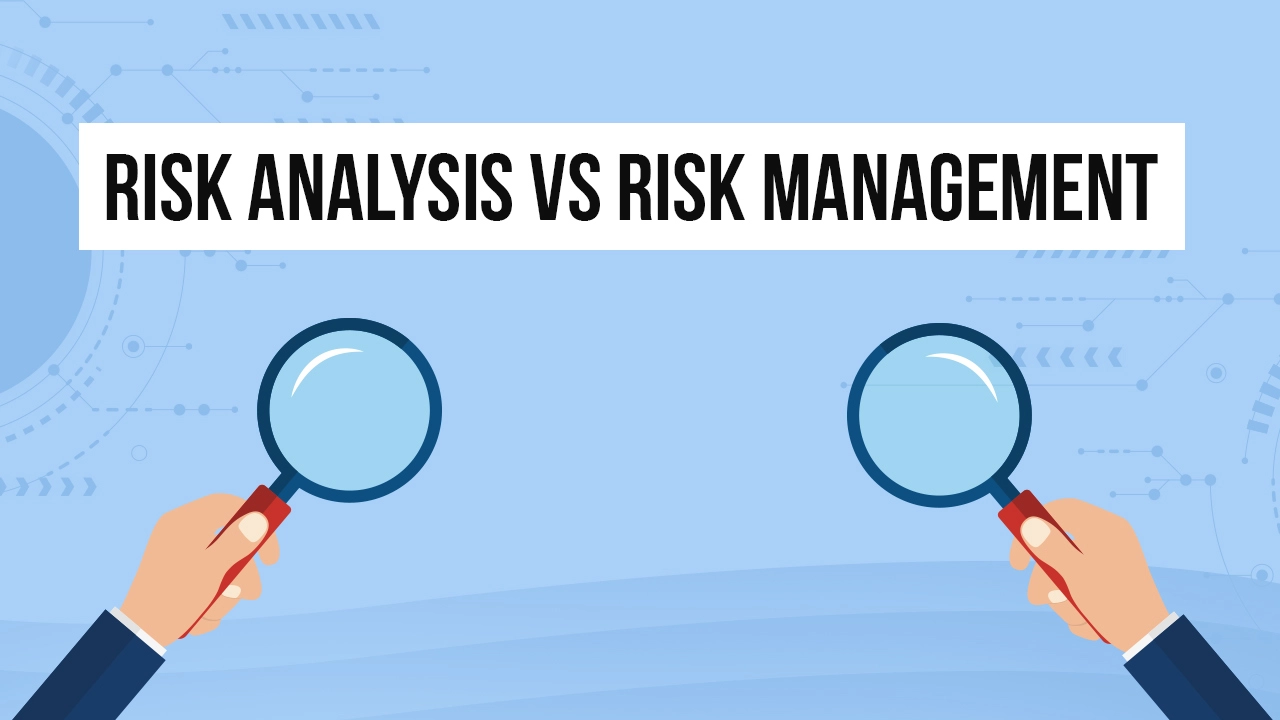Index
- Intoduction
- Understanding Risk Analysis in Cybersecurity
- What is Risk Analysis?
- Key Components of Cybersecurity Risk Analysis
- Methods and Approaches to Cybersecurity Risk Analysis
- Benefits of Cybersecurity Risk Analysis
- What is Cybersecurity Risk Management?
- Key Components of Cybersecurity Risk Management
- Challenges in Cybersecurity Risk Management
- Bridging the Gap: Risk Analysis vs. Risk Management
- Strategies for Effective Integration
- Conclusion
- FAQs
Risk management and risk analysis are both vital processes for any business to mitigate and manage potential risks effectively. While these terms were often used interchangeably, they represent different objectives and different processes. Understanding the difference between cyber risk management and cyber risk analysis is essential for businesses to efficiently manage risks and construct strategies to safeguard themselves from potential damages and losses.
Basically, a risk analysis is a singular step in the whole cyber risk management process. The analysis entails testing each risk to the security of your business’s information systems, data, and devices and prioritizing the potential threats.
Understanding Risk Analysis in Cybersecurity
A cybersecurity risk analysis is the procedure of detecting, evaluating, and analyzing risks. It allows you to ensure that the cybersecurity controls you select are appropriate to the risks that your company faces.
Without a risk analysis to inform your cybersecurity choices, you could waste resources, time, and effort. There’s little point in implementing measures to safeguard against events that are unlikely to occur or won’t impact your company. Likewise, you can overlook or underestimate risks that could cause a big impact. This is why there is a strong need for risk analysis.
What is Risk Analysis?
A cybersecurity risk analysis needs an organization to determine its core business objectives and detect the information technology assets that are vital to realizing those objectives. It is then a case of detecting cybersecurity attacks that could severely harm those assets, determining the chances of those attacks happening and understanding the impact they could have.
To sum it up, it is drafting a whole picture of the threat ecosystem for certain business objectives. This allows security teams and stakeholders to make informed decisions regarding where and how to implement security measures to mitigate the overall risks to one with which the organization is comfortable.
Key Components of Cybersecurity Risk Analysis
Utilizing a cybersecurity risk analysis checklist can assist you in understanding the risks and strategically enhance your processes, procedures, and technologies to minimize the chance of financial losses. Here are the key components of cybersecurity analysis:
● Detection & Classification of Assets
The first thing you need to do is to create a full inventory of valuable assets across the company that could be threatened, resulting in monetary loss. The label of each group or asset is assessed according to the sensitivity levels. It is as defined by the data classification policy. Classifying assets not only assists with cybersecurity risk analysis but will also guide you in implementing cybersecurity processes and tools to safeguard assets properly.
● Identification of Threats
Basically, a threat is anything that can harm your assets. While there are many different kinds of cybersecurity threats, here are some of the common ones:
- Accidental human errors
- System failure
- Malicious human actions
For each asset in your list, you need to make a thorough list of threats to it.
● Vulnerability Assessment
A vulnerability is basically a weakness that could enable threats to make a severe harmful impact on the assets. You need to document the tools and processes that are currently safeguarding your key assets and look for further vulnerabilities.
● Impact Analysis
After that, you need to detail the impacts that the business would suffer if a given asset were damaged. Anything that could lead to financial losses could be considered as such an impact.
● Security Control Strategy
By utilizing the risk management plan, you can create a broader plan to implement security controls and mitigate risks. You need to rank the probable controls by their impact and create a strategy for reducing your most critical risk.
● Compliance Assessment
Assessing your compliance with applicable laws and standards is vital to mitigate the dangers of financial loss. As part of your security risk assessments, ensure you identify which standards and regulations are subject to and what risks could put your compliance in danger.
● Incident Response Plan
Businesses need plans for incident response to contain and mitigate the damage from threats that become realized. To help ensure effective and prompt response to incidents, your plan should cover multiple aspects.
● Recovery Plan
A recovery plan should assist in guiding a quick restoration of the most vital systems and data in the event of a disaster.
Methods and Approaches to Cybersecurity Risk Analysis
Here are the methods to do cybersecurity risk analysis:
- The first thing you need to do is assemble a team with the right talents and qualifications. A cross-departmental group is vital to identify cyber threats and mitigate risks to IT data and systems. The cybersecurity risk management team should catalogue information on all of your assets.
- There are certain types of information that are more vital than the others. In terms of being secure, not all vendors are equal. Therefore, when all the information assets are identified, it is time to assess their enterprise and risks.
- Consider thoroughly understanding and weighing in the probability and impact of the risks. To establish the tolerance level of risks, multiply the probability by the impact, and then, with each risk, you can determine your response.
- Up next, you need to define and implement security controls. Security controls will assist you in managing the potential risks so they are eliminated or the chance of their occurrence is substantially reduced.
- You can implement periodic audits and monitor how effective your analysis is. By doing so, you can make the necessary changes to upgrade your approach and measures.
Benefits of Cybersecurity Risk Analysis
- Any possible internal or external threats or risks that could compromise your network or endpoints will be found during the cybersecurity risk analysis.
- Understanding the dangers and threats that could affect your company. It will help you determine whether the security measures you have in place are effective.
- Risk assessments are updated with the newest cyber threats, so they will always indicate to your company if it is adequately prepared to fend off the most recent attacks.
What is Cybersecurity Risk Management?
Cybersecurity risk management is all about always-running processes of evaluating, identifying, addressing, and analyzing your company’s cybersecurity threats. It is just not about a single role or aspect of the organization. Everyone has a part to play in Cybersecurity risk management. You absolutely need cyber risk management to help you with the analysis.
Key Components of Cybersecurity Risk Management
- Threats are situations or occurrences that could have a detrimental impact. It is especially harmful to the assets or operations of an organization by allowing unauthorized access to information systems. Everywhere can provide a threat. And it is irrespective of whether through hostile acts, mistakes made by people, malfunctions in structures or configurations, and even natural calamities.
- Determine every potential danger and weak point in your setting. Implement the necessary safeguards to address all known vulnerabilities at this time.
- Maintaining a current understanding of all legislation and any changes made will guarantee that your internal controls meet external standards. Whenever new vendors join the company, make careful to evaluate and record security and compliance controls. Recall that their flaws could cause you headaches.
Challenges in Cybersecurity Risk Management
Systems that don’t adhere to security requirements come with genuine hazards and obstacles. Therefore, adherence to cutting-edge information security standards and proper cyber risk management must be a keystone of any security plan. The problem here is that organizations frequently feel overwhelmed by conflicting rules, guidelines, and best practices, which makes the process of complying with regulations a nightmare. The knowledge needed to implement these standards of cyber risk management in accordance with corporate goals makes employing external security teams, especially for smaller businesses, a pricey endeavour.
Bridging the Gap: Risk Analysis vs. Risk Management
Risk analysis is a small part of cyber risk management. In simple terms, risk analysis is basically looking out for vulnerabilities and potential vulnerabilities. From identification to retention, there are a lot of processes in risk analysis. Cybersecurity risk management is basically mapping out objectives and measures that can address any sort of vulnerabilities present in the risk analysis.
Strategies for Effective Integration
A proper cybersecurity analysis and cybersecurity risk management can help businesses in both the short and long term. Here are four things you must know when the conversation is about effective integration:
- Identify vulnerabilities
- Identify potential threats
- Provide threat recovery options
- Provide impact of threats
Conclusion
In addition to providing businesses and large corporations with ultimate security, cybersecurity analysis and cybersecurity management identify and address all the risks and potential vulnerabilities in every corner of your organization.
While tackling all these on your own is not at all a walk in the park, you can always seek assistance from a reliable company to carry out the approaches for the best security. At 63SATS, our comprehensive solutions extend to defence-grade secured communications and cloud security, ensuring a robust architecture from inception to runtime.









